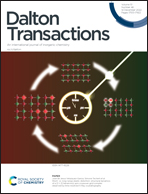Flexible ligand–Gd dye-encapsulated dual-emission metal–organic framework†
Abstract
Multiple emission metal–organic frameworks (MOFs) are superior materials for ratiometric fluorescence sensing and visible detection applications. The guest-encapsulation strategy is a simple method for the integration of the open structure of MOFs and the abundant choice of emissive guests. Herein, we reveal the factors that affect the performance of host–guest multi-emission MOFs based on the choice of ligands, metal nodes, and guest dyes. The size of organic dyes is often larger than 1 nm, which is incompatible with the small pores of traditional MOFs. Therefore, we selected a flexible ligand, i.e., 1,3,5-tris(5-methoxy-1,3-benzene dicarboxylic acid)benzene (L), to enlarge the pore size of the MOF to 18 Å. Energy transfer may occur from the ligand and guest dye to the metal nodes; thus, we selected the Gd3+ ion because of its high excited state level. L and Gd3+ ions were used to form the Gd–L MOF with the pore size of 18 Å, as revealed by the single crystal result. Rhodamine B (RhB), as the guest dye with the size of 15.9 × 11.8 × 5.6 Å3, was encapsulated in Gd–L MOF, which was denoted as RhB@MOF. The matched size between RhB and the MOF pore and the breathing effect of the flexible MOF effectively prevented the leakage of RhB. Accordingly, dual emission was observed at 360 nm and 583 nm under the excitation of 290 nm from RhB@MOF. Alternatively, Cu2+ quenched the emission at 360 nm due to the electron transfer process, while Fe3+ interacted with both L and RhB, and thus quenched the two emissions simultaneously. However, other metal ions showed little effect on the two emissions. Consequently, the differentiation between Cu2+ and Fe3+ as well as them from other metal ions was realized with the dual-emission MOF. Thus, the guest-encapsulation strategy is simple and flexible ligands are efficient to encapsulate molecular dyes for dual-emission MOFs to improve their sensing performance, while flexible ligands are powerful to enhance the capacity and extend the applications of MOFs.



 Please wait while we load your content...
Please wait while we load your content...